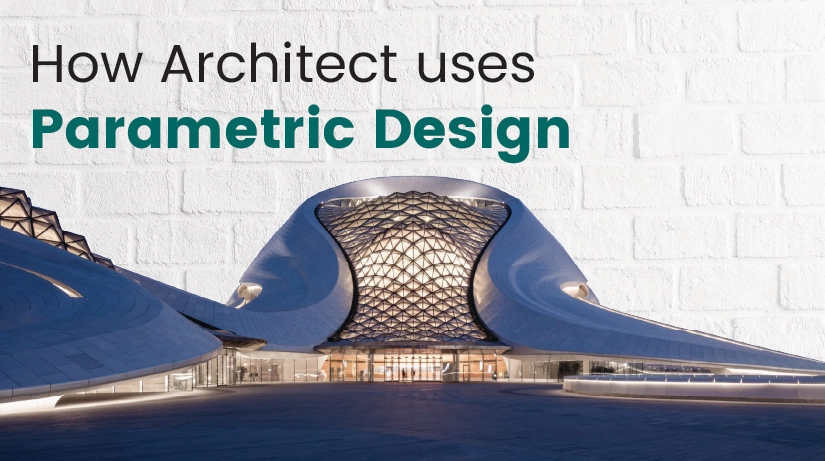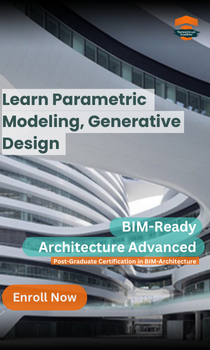Understand In Detail How Architect uses Parametric Design
Feb 19, 2024
Category: BIM / Digitization / Automation
SEO TSA

Parametric design is the most discussed design approach among architects as it is an algorithm-based technique. It combines the design objective with the design outcome. Moreover, it attracts the attention of nearly everyone by creating intricate structures and geometries through the interaction of several materials. Let us explore parametric design in architecture in more detail.
What Is Parametric Design In Architecture?
Parametric design is an approach in which architects employ algorithms to construct complicated, customised items or structures. Through this procedure, designers can provide a collection of variables or parameters that the algorithm will use to provide a unique answer.
For example, an architect might enter the measurements of a site, the amount of sunlight it receives, and the kind of soil there. After that, the algorithm would produce a specially designed solar panel that is ideal for that particular location.
This technique is adaptable and can be used for a variety of issues in architecture, engineering, and product design. However, generative design is a related approach that is more concerned with determining the best solution for a given problem than tailoring a solution to certain inputs.
The Path Of Parametric Design In Architecture
In the field of AEC, the term “parametric architecture” has recently become popular. But Antoni Gaudi’s most famous creation, La Sagrada Familia, dates back to the 19th century, which is where it all began. When the building’s representational models with dangling chains were flipped, they formed a building structure.
In the 1960s, architect Luigi Moretti formerly utilised mathematical and parametric equations to analyse spatial interactions. It is thought that Rome’s layout was planned using these calculations. According to some, Luigi is recognised for coining the term “parametric architecture”. Ivan Sutherland’s Sketchpad was the first software or programme to use these parametric equations.
Subsequently, Non-Uniform Rational B-Splines (NURBS) were discovered in 1989 as a means of 3-dimensional modelling software. The first software versions by NURBS included the terms “wrap” and “fold,” which are the origins of parametric modelling.
Moreover, these modelling systems are the most widely used programmes in current parametric architecture. Prominent architects including Frank Gehry, Jean Nouvel, and Zaha Hadid have made substantial contributions to the application of parametricism in architecture.
Workings Of Parametric Design In Architecture
These are the steps to understand the workings of parametric design in architecture.
♦ The process of creating a computer-aided design tool, including parametric design as well as modelling, involves computational methodologies in the form of computer languages to solve design difficulties.
♦ When using parametric modelling, the procedure is just as significant as the result. It operates in a succession of sequential, logical steps.
♦ Because of this, it differs from the direct modelling of 3D which is more common, which applies the push-and-pull method directly to the geometry. Since visual programming powers the majority of parametric modelling interfaces, programming language knowledge is no longer a must.
♦ Architects must aggregate any elements or programmes in place of text codes, with inputs placed on nodes and connected to the following node.
♦ When a node connects to other nodes, it can function as both an input and an output. The sequence can branch out since it can be connected to multiple nodes. There is no doubt that these nodes come together to create a sequence or graph as a result of several connections. The virtual representation of each of these input nodes is the output.
♦ Now that all these factors have been processed, the programme generates the best possible structure while staying within the specified range. After that, the architect adds their artistic touches by making the required changes to the outcome.
Advantages Of Parametric Design In Architecture
Parametric architectural designs surely mark the beginning of an exciting future, bringing with them characteristics that have the potential to change the game. Some of the main advantages of parametricism are:
Effective while maintaining aesthetics
The laws and regulations of nature have always constrained the ability of an architect to create fascinating structures. Although the artists have always been able to swim against the current, an important practical effect was never achievable.
These years have taken up a lot of time, effort, attempts, and missteps to bring frameworks into reality from the visualisation. Captivating designs that have no restrictions on shapes, symmetry, or designs are now feasible in architecture because of this design. The creative touch of architects should also not be overlooked. That would be a blend of efficiency and beauty.
An improvement in accuracy and speed
Parametric design allows you to specify logical rules that describe the model and the relationships between its pieces, together with a set of parameters that drive the logic, in place of manually adding and manipulating every part of the model. Based on your parameters, the design tool then computes and generates a dynamic 3D model.
A significant productivity boost results from eliminating manual labour since the model can be produced much more quickly. Automated design generation also reduces the possibility of human error, which might, in the worst case scenario, compound into expensive miscalculations.
Quick revisions and adaptability to changes
Dealing with revisions is also a lot simpler with this model’s creation method than it is with a typical 3D model or even 2D CAD. Any changes to the model appear across the entire design using the set logic.
As a result, rapid iteration is achievable while adhering to the requirements and limitations of the design. Agile testing makes it possible to find novel, potential solutions that could reduce project costs. Moreover, the model is easily adaptable to any new requirements that may arise.
Many choices for the same concept
Parametric design is a novel method of architectural design that relies on the idea of parameters. It defines a variety of formal alternatives by using parameters to establish relationships between design elements.
Thus, architects have a lot of opportunities to engineer the design process more effectively with this design. These days, architects choose to alter just one option, opening up a multitude of options and fixes.
Data Usage
One of the many advantages of this design in architecture is the utilisation of data. It now takes minutes to do tasks that once took days or even months to complete. Numerous workable solutions may become available.
Thus, architects need to comprehend the wants of the clients and enter the same information while considering any potential filters and constraints. It is possible to create new tools that fulfil distinct needs.
Improved productivity and superior design quality
Parametric design has clear advantages, including dynamic automation, improved accuracy, quick iterations, and additional resources for the overall design. It is particularly useful in intricate constructions with non-traditional architecture.
Although, architects may apply it to any size project. By streamlining work, producing excellent designs, and completing projects successfully, this design elevates the modelling process.
Drawbacks of Parametric Design
Although parametric design offers a lot of potential for use in architecture, it also has drawbacks of its own. The steep learning curve needed to become proficient with the sophisticated tools and algorithms used in this design is one of the primary challenges.
This design presents an additional difficulty in terms of cost and resources. Many architects and design organisations may find it prohibitive to purchase the software and hardware needed for parametric design, even if the use of computational techniques can save time and resources when compared to traditional design methods.
Furthermore, this design has its limitations in terms of what it can accomplish. Although this method can produce extremely intricate and effective structures, there are still certain restrictions on the outcome.
For instance, creating structures with non-rectilinear geometries or irregular shapes may not fit parametric design well. It’s also critical to remember that this design cannot take the place of strong design knowledge and abilities. Instead, it is a tool that can assist designers in experimenting with and producing novel design ideas.
Conclusion
Parametric design is a novel approach to architecture that is transforming the way people think about design as well as construction. This method offers architects and designers a great deal of possibilities to develop extremely complicated and efficient structures that were previously unattainable. This could range from sustainability to efficiency.
Although this design has drawbacks and restrictions, it has the unquestionable potential to increase architectural possibilities. As this approach develops further, people should anticipate seeing even more fascinating and cutting-edge architectural ideas.








